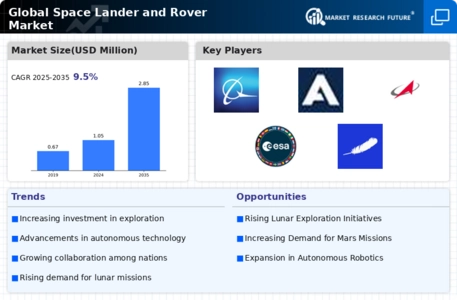Market Analysis
In-depth Analysis of Space Lander Rover Market Industry Landscape
The market for space landers and rovers symbolizes a new frontier in discovery and humanity's pursuit of understanding the secrets of the universe. International cooperation, space exploration assignments, and technical innovation are the driving forces behind market dynamics in this industry. The market for space landers and rovers is shaped by the unwavering quest of scientific knowledge and the desire to investigate celestial objects. In this industry, the most important factor influencing the marketplace is technological progress. Innovations in systems for propulsion, robotic arms, along with self-navigating systems improve space landers and rovers' adaptability and performance. The market reacts to scientific and engineering advances that push the limits of technical feasibility by developing innovative solutions that support increasingly ambitious ventures into space missions. The changing conditions of the space lander and rover industry are significantly influenced by space agencies and commercial aerospace companies. Significant exploratory initiatives are led by funded by the government aerospace organizations including NASA, ESA, and numerous others, which increases demand for advanced landings and rover systems. In addition, the commercial aspect that private enterprises' involvement in the space sector brings to the market encourages competitiveness and innovation. One of the key differentiators within the market is worldwide collaboration. Through joint ventures, nations and space agencies can pool assets and expertise, which lowers costs and broadens the area of exploration. The Global Lunar Gateway is one example of a collaborative project that demonstrates the close knit nature of the space community is worldwide and how this influences market conditions. One of the main forces influencing the market landscape is the investigation of celestial planets, such as the Moon and Mars. Dedicated landers and rovers are becoming more and more necessary as space-related agencies and private companies organize and carry out missions to these locations. These automated explorers are vital for carrying out research, acquiring data, and obtaining specimens that advance our knowledge of the galaxy. The market trends regarding space landers & rovers are also influenced by commercial potential in the study of space. Influenced by the potential for lunar tourism, meteorite mining, and other business endeavors, private corporations invest in the development of dependable and affordable landing and rover technology. The confluence of business goals and scientific discoveries generates a vibrant marketplace with a wide range of participants. One significant trend impacting the market for space landers and rovers is the shrinking of technology. Smaller and lighter rovers and landers provide more affordable options for exploring outer space. The deployment of these small systems on tiny spacecraft can lower launch costs and increase the viability of space missions. A wider spectrum of businesses can now take part in the space program because to the trend toward downsizing. The market patterns for space landers & rovers are also influenced by legislative and financial considerations. The choices regarding investments undertaken by authorities and private companies are influenced by funding allotted for space exploration expeditions modifications to space regulations, and geopolitical variables. In order to guarantee the long-term viability of their space-related projects, market participants need to manage these outside forces. In summary, the market for space landers and rovers functions at the nexus of international cooperation, technological advancement, and scientific investigation. The market dynamics are always changing as mankind grows beyond Earth because of the global space community's combined efforts, commercial opportunities, and knowledge-seeking endeavors. Uncovering the mysteries of space and laying the groundwork for upcoming space missions projects depend heavily on the fabrication of sophisticated and adaptable space landers and rovers.









Leave a Comment